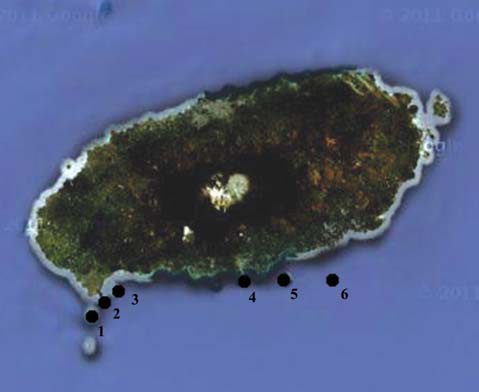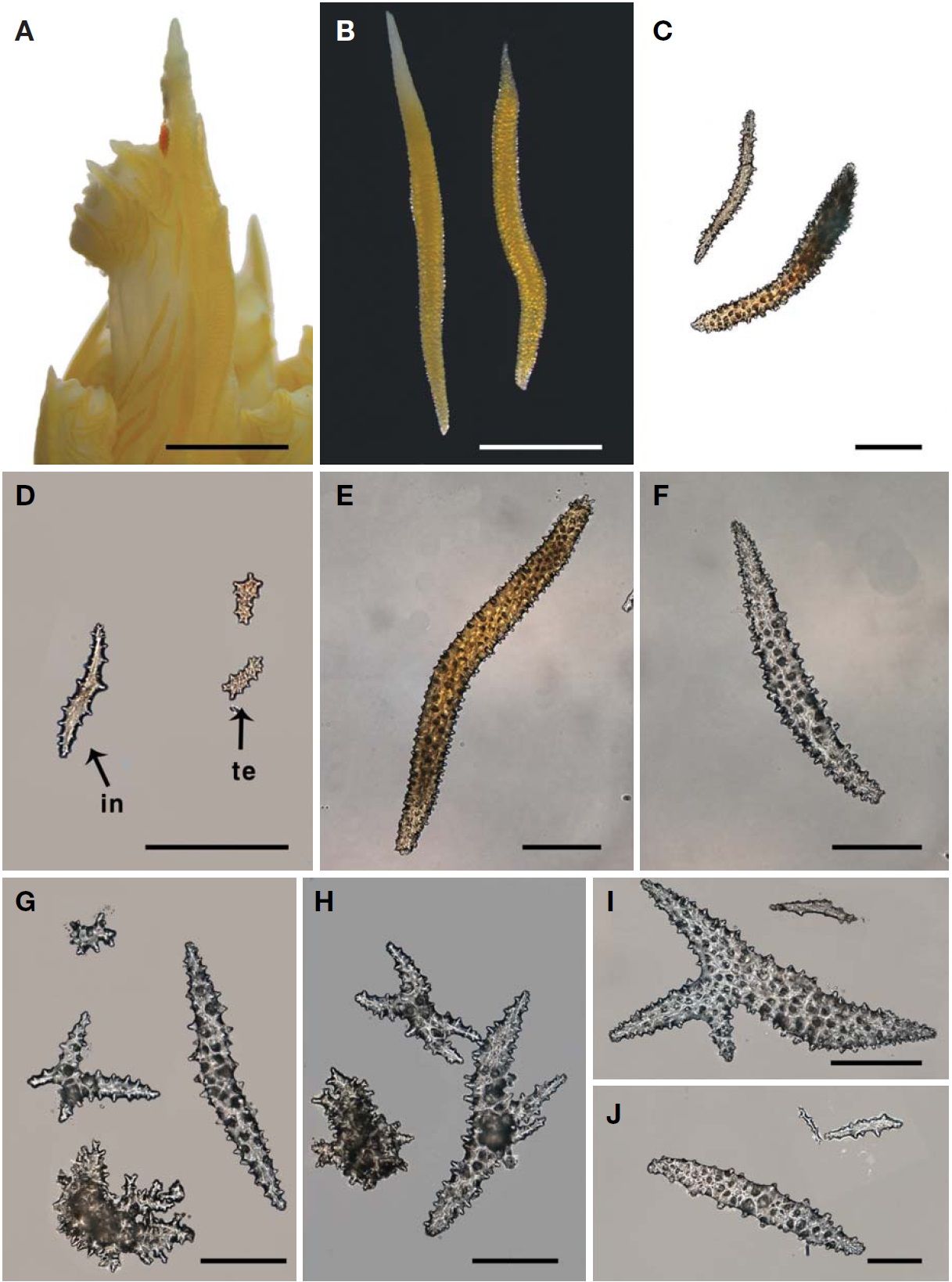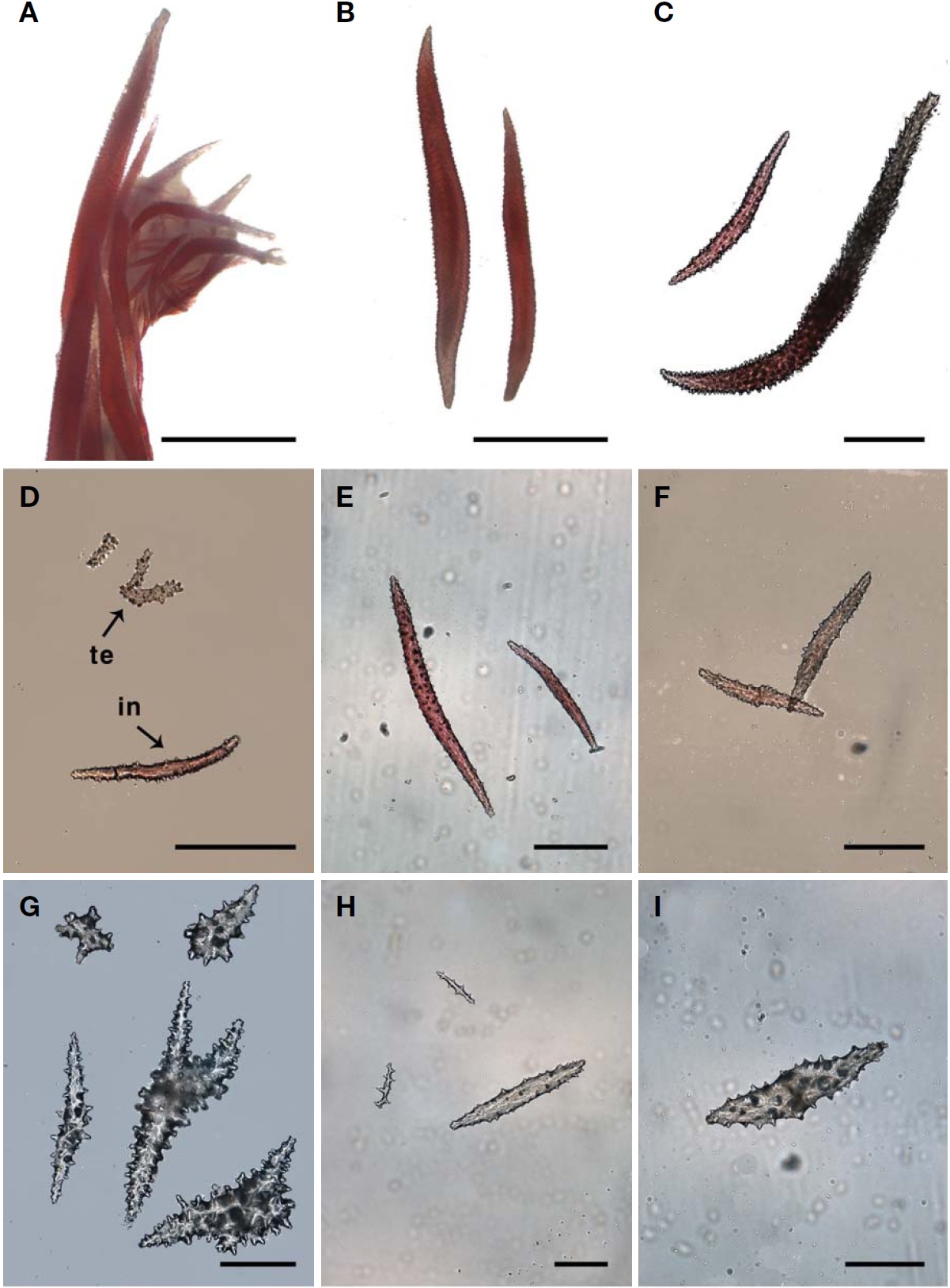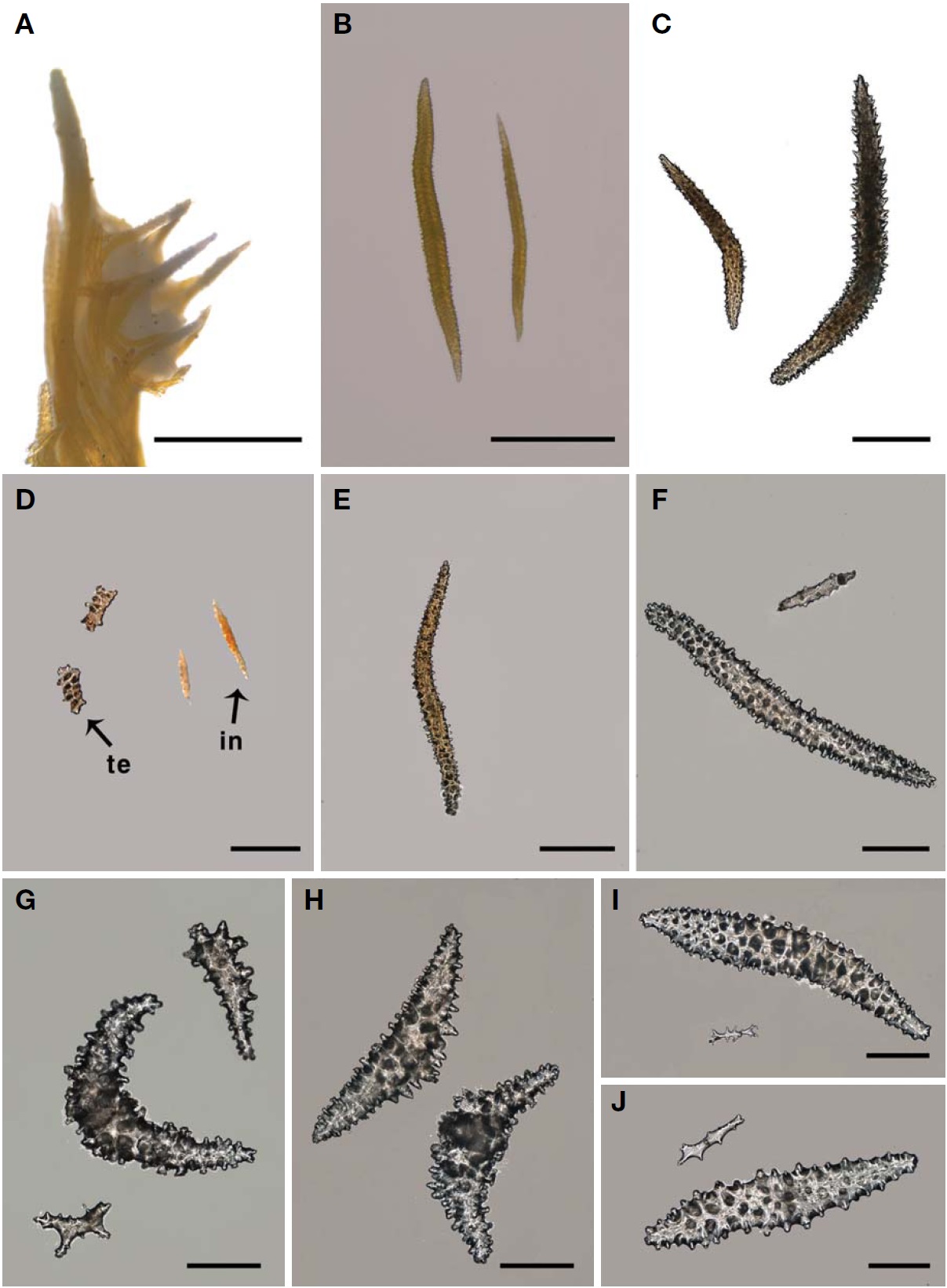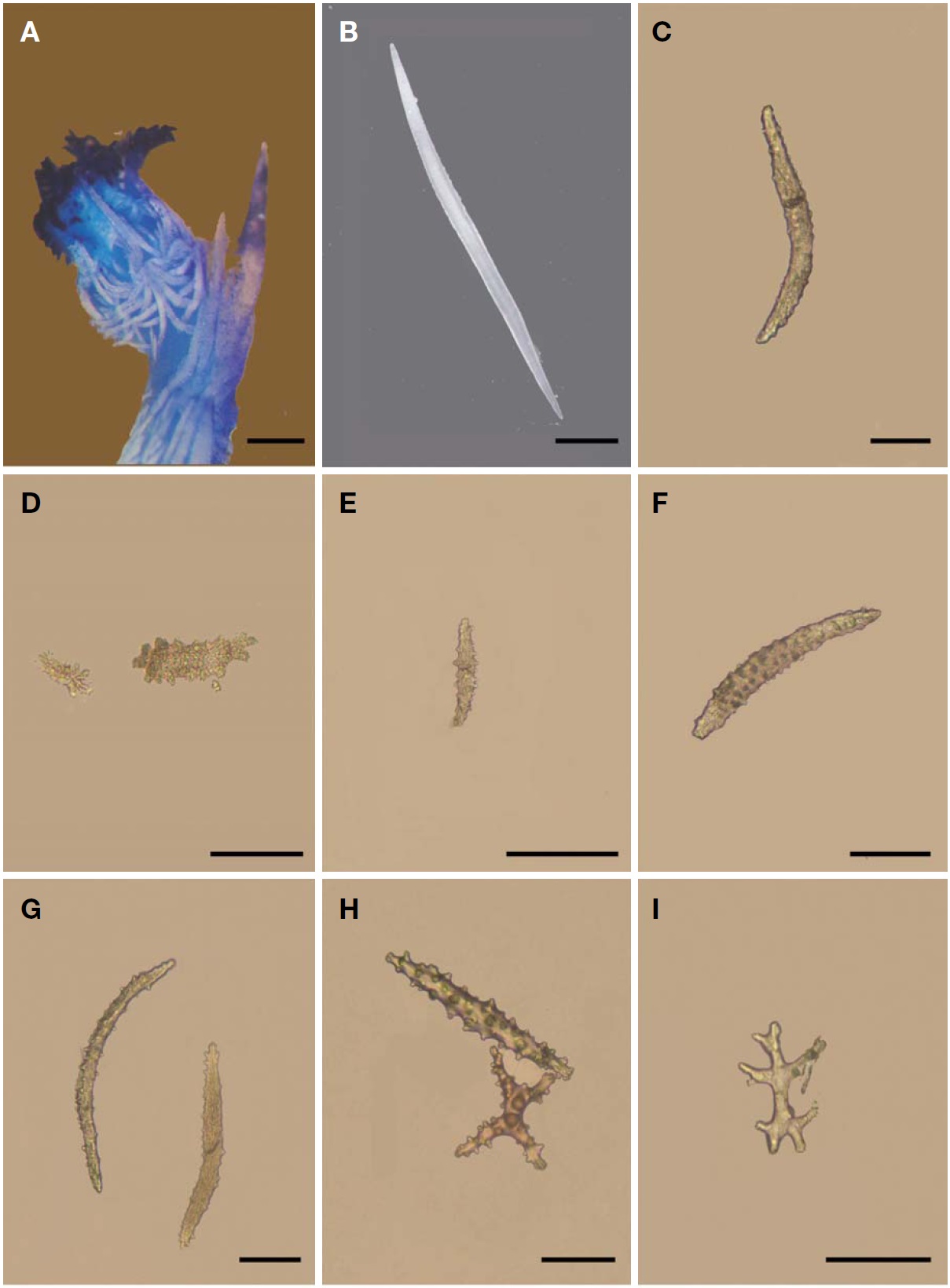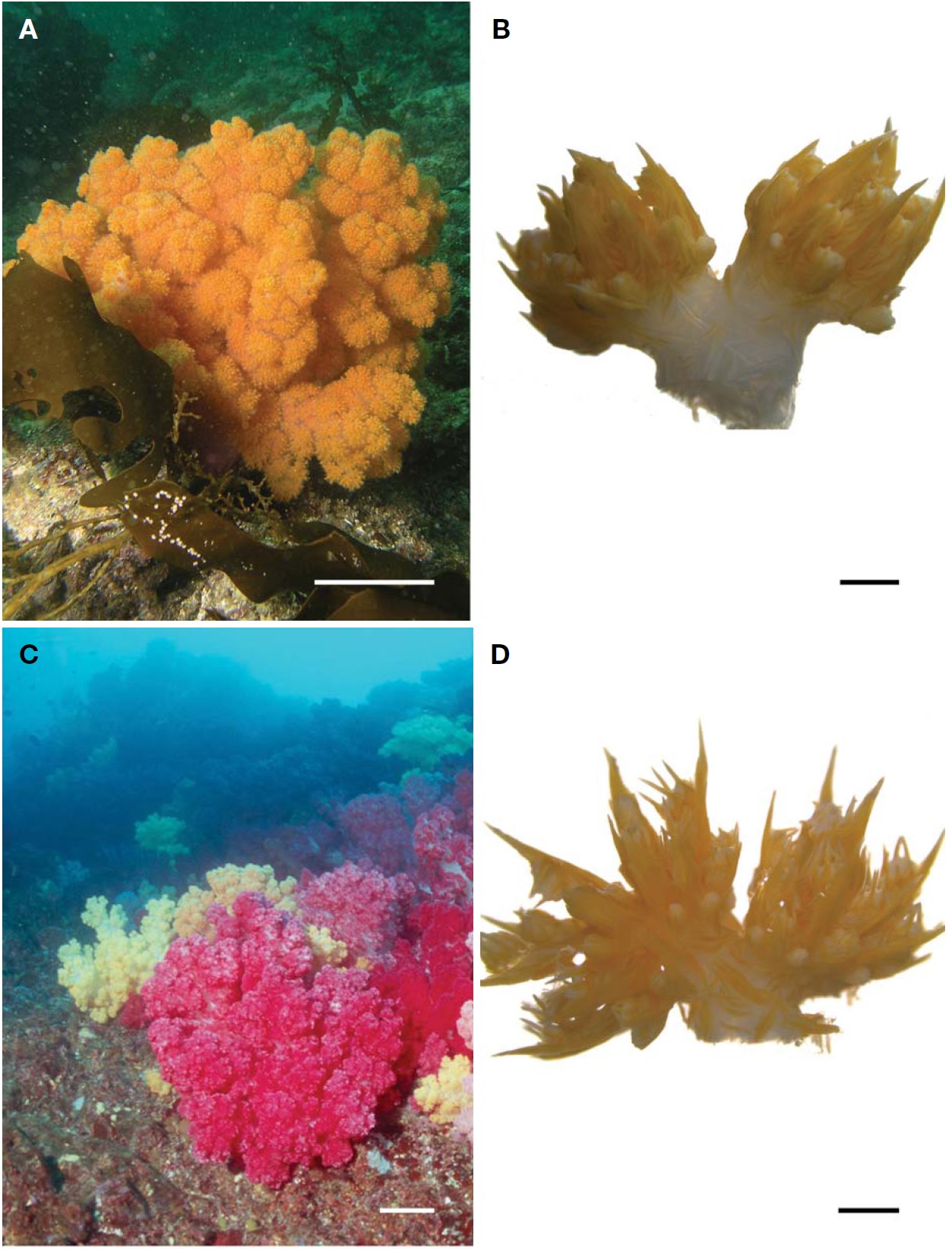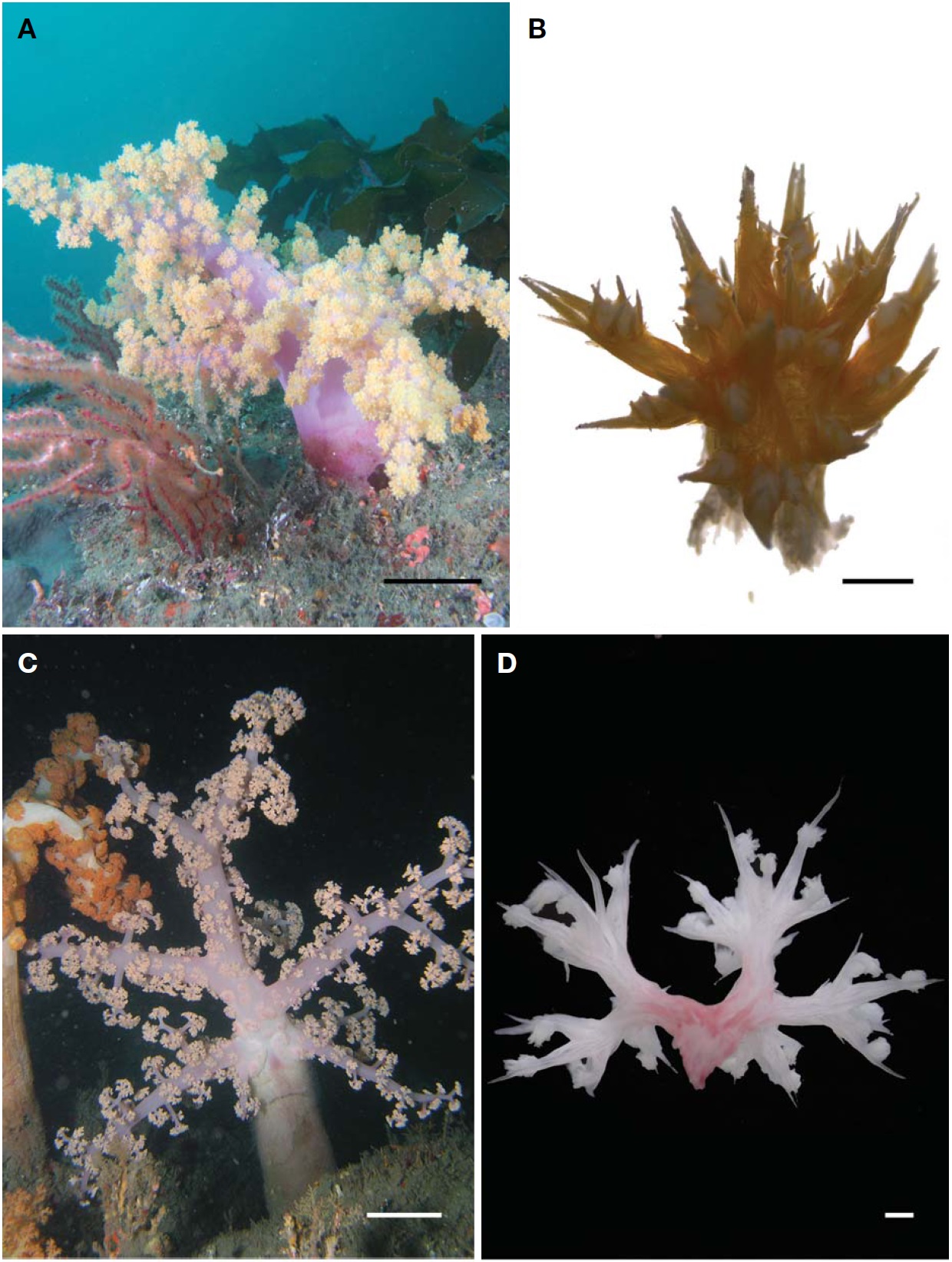



The genus
Among the 250 recorded species of
All specimens examined in this study were collected from subtidal zones of Jeju-do between depth of 10 and 32 m by SCUBA or fishing nets between 1975 and 2010 (Fig. 1). Collected specimens were anesthetized with menthol for 6-8 h, and were then fixed in 4-5% (v/v) formalin with seawater. After that, fixed specimens were washed with tap water, and preserved in 70% alcohol (v/v).
For identification, each specimen was examined for morphological characteristics such as growth form, size of each part of colony, polyp, and sclerite, anthocodial armature and grade, and coloration under stereomicroscopes (Semi SV-6 and SV-11; Carl Zeiss, Jena, Germany and S8APO; Leica, Wetzlar, Germany) and a light microscope (Eclipse 80i; Nikon Co., Tokyo, Japan). The color of each part was recorded with a color code based on the color chart (新配色カ一ド199b, Japan Color Research Services Company, Japan). To examine the sclerites, a bit of tissue from the each part was dissolved in a diluted solution of the clorox for five minutes. In addition, the white sclerites of the polyp head were stained with a mixture of methylene blue and ethanol for the visualization of anthocodial arrangement.
Images of the living dendronephthya colonies under water were taken by a digital camera (5060-WZ; Olympus, Tokyo, Japan) with an underwater housing (Patima-7070; Patima Uw_Eng Co. Ltd., Seoul, Korea). Further images of the collected specimens were taken by a digital camera (G7; Canon Inc., Tokyo, Japan) prior to fixation. Images of polyps and
supporting bundles (SBs) were taken by a stereomicroscope (S8APO; Leica) with camera (DFC 290; Leica). The size of the polyps and SBs, and angle of SB to polyp head were then measured using an image analyzer (LAS version 3.6; Leica). Images of sclerites were taken by a light microscope (Eclipse 80i; Nikon Co.) mounted with a camera (DS-5Mc; Nikon Co.), and the size of sclerites were then calculated with an image analyzer (NIS-Elements BR 3.0; Nikon Co.). In addition, the image editing program (HeliconFocus 5.1 Pro; Helicon Soft Ltd., Kharkov, Ukraine) were used to create one completely focused image of the sclerite from several partially focused images by combining the focused areas.
For the identification and classification, Utinomi’s subgenera classification based on the division of colonial growth form by Kukenthal (1905), and the anthocodial grade and formula by Sheriffs (1922), were followed. Terminology is based on the literature, illustrated trilingual glossary of morphological and anatomical terms applied to Octocorallia (Bayer et al., 1983).
Phylum Cnidaria Hatschek, 1888
Class Anthozoa Ehrenberg, 1834
Subclass Octocorallia Haeckel, 1866
Order Alcyonacea Lamouroux, 1816
Family Nephtheidae Gray, 1862
Diagnosis. Upright and branched colonies with a usually distinct sterile stalk which bears a dendritic branching mass of polypiferous ramifications. Polyps not retractile.
Genus Dendronephthya Kukenthal, 1905
Diagnosis. Polyps always form a small bundle or occasionally large bundle. Polyp with SB.
1*Subgenus Dendronephthya Utinomi, 1962
Diagnosis. Colonial growth form glomerate by branching slightly, grouping the bundles of polyp in smaller or larger rounded bunches, and so making the irregular surface of polyparium.
2*Dendronephthya (Dendronephthya) aurea Utinomi, 1952 (Table 1, Figs. 2,6A, B)
[Table 1.] Diagnostic characters on sclerites of Dendronephthya (Dendronephthya) aurea
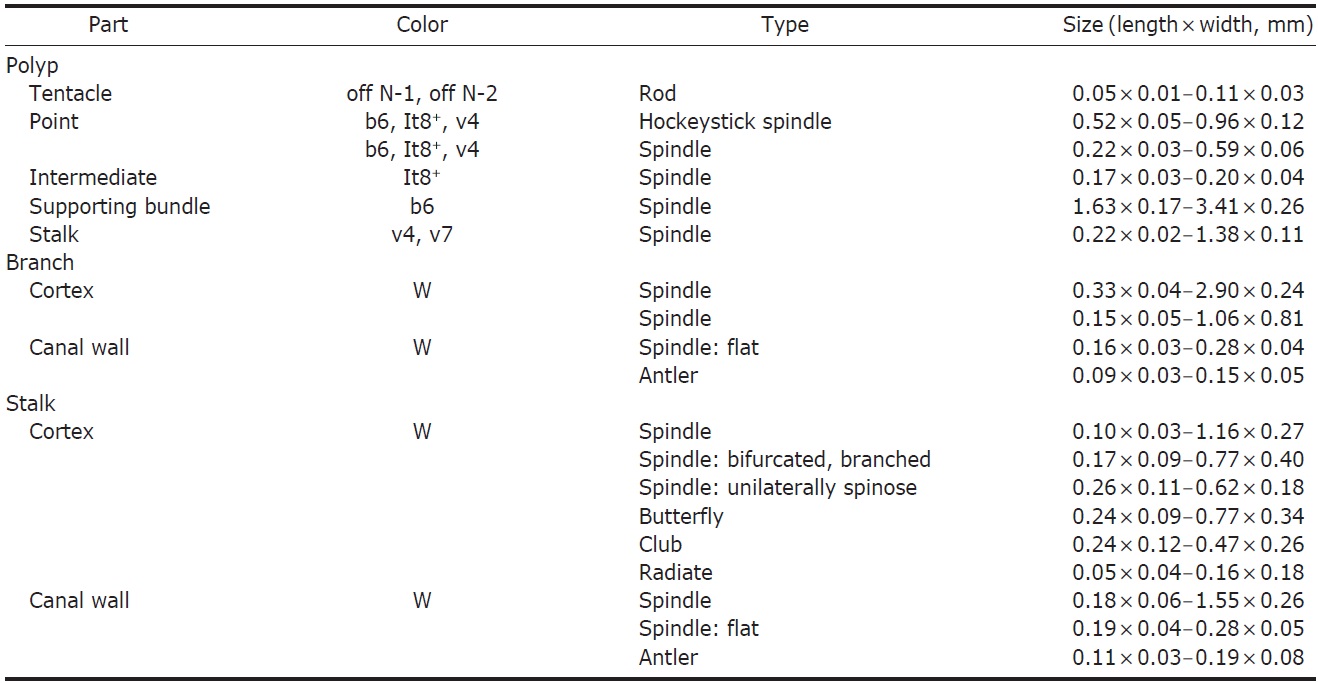
Diagnostic characters on sclerites of Dendronephthya (Dendronephthya) aurea
Material examined. Korea: 1 colony, Jeju-do: Seogwipo-si, Munseom, 22 Jan 1998, Song JI, Lee YJ (EWZS3955); 1 colony, Seogwipo-si, Seopseom, 33°13′45.85′′N, 126°35′ 46.47′′E, 13 Jan 2009, Hwang SJ (EWZS3801), 18-26 m deep by SCUBA diving and underwater camera.
Description. Glomerate. Compact, rigid colony with short and wide stalk. Height of colony over 30 cm in alive. But, contracted specimens of colony 72 and 95 mm high, 54 and 74 mm wide, of which sterile stalk 33 and 20 mm long, 19 and 40 mm in wide, respectively. Main branches up to four, compactly grouped with rounded terminal branches. Foliaceous lower branches short or widen, and covered upper part of stalk or not. Rounded of polyp bundles closely covered main stem and branches. Each bundle composed of 16-24 polyps. Polyps compactly arranged in almost parallel.
Polyps about 2.8-3.9 mm long with 1.1-1.5 mm of stalk. Flat polyp head stands at obtuse angle with stalk, 0.49-0.67 mm high and 0.73-0.97 mm wide. Anthocodial armature composed eight pairs of points. Usually one of uppermost pair like hockeystick, larger and broad toward tip, not projected or sometimes far from polyp head about average of 0.19 mm, sometimes up to 0.40 mm with obliquely upwards thorns on free end. Intermediate sclerites between each pair of points absent or up to one pair. Crowns and supplementary sclerites absent. Tentacle sclerites loosely in rows, sometimes unseen. SBs normally composed of three or four spinose spindles, and usually one strongly projected from head over 0.67-1.56 mm, additional one extended short distance. Long and thick spindles loosely on stalks.
Anthocodial grade and formula:
III=1P+(2-4) p+0Cr+very strong SB+(0 or 1/2-1)M
On cortex of branch, spinose spindles densely disposed, mainly straight or curved, varying in size. Various types of sclerites on cortex of stalk, warty or spinose spindles majority, straight or bent, sometimes bifurcated or branched. Others unilaterally spinose spindles, four-rayed sclerites like ‘butterfly’, club, radiate, irregular bodies. On canal wall of branch and stalk, spindles and antler. Straight or curved spindles sometimes bifurcated or branched, and smaller spindles flat. Detailed color, type, and size of sclerites of each part measured in Table 1.
In living, stalks white or reddish white, white main stems and branches white. Sclerites of polyp and SBs golden yellow, but sometimes polyps partially yellowish red. Free tips of SB and uppermost points somewhat white. Rods of tentacles colorless or light yellow, sometimes red. In alcohol,
stalks, main stems, branches wear paler, and especially upward stalk.
Habitat. This species inhabits on the gentle slope of rocks between depth of 18 and 26 m, and shows ectosymbiosis with the polychaetes.
Remarks. This species was characterized by the glomerate colonial form similar with
Distribution. Pacific Ocean: Korea (Jejudo Island), Japan (Sagami Bay, Kii coast), Vietnam.
1*Dendronephthya (Dendronephthya) koellikeri Kukenthal, 1905 (Table 2, Figs. 3,6C, D)
[Table 2.] Diagnostic characters on sclerites of Dendronephthya (Dendronephthya) koellikeri
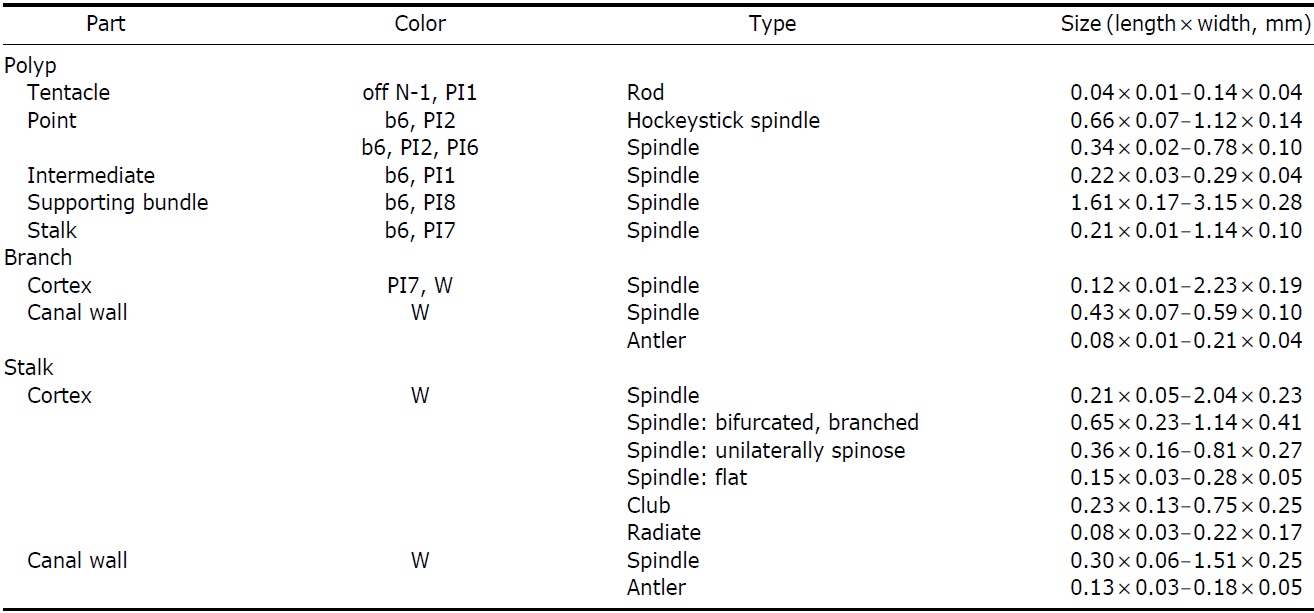
Diagnostic characters on sclerites of Dendronephthya (Dendronephthya) koellikeri
Material examined. Korea: 1 colony, Jeju-do: Seogwipo-si, Seopseom, 28 Nov 2005, Hwang SJ (EWZS1234); 1 colony, Seogwipo-si, Daejeog-eup, Songaksan, 33°12′15.51′′N, 126° 17′34.66′′E, 1 Sep 2008, Hwang SJ, Cho IY (EWZS2631); 1 frag., Seogwipo-si, Andeok-myeon, Hyungjaeseom, 33°12′ 34.71′′N, 126°19′07.04′′E, 2 Sep 2008, Hwang SJ, Cho IY (EWZS2629); 1 frag., Seogwipo-si, Andeok-myeon, Hyungjaeseom, 33°12′34.71′′N, 126°19′07.04′′E, 2 Sep 2008, Hwang SJ, Cho IY (EWZS2630), 10-23 m deep by SCUBA diving and underwater camera.
Description. Glomerate. Massive and compact colony with short and wide stalk. Height of colony up to 50 cm in alive. But, small specimens of colony 63 and 84 mm high, 84 and 43 mm wide, of which sterile stalk 14 and 20 mm long, 25 and 14 mm in width, respectively. Sterile stalk occupies up to quarter of whole length of colony in expanded state. Branches rise from whole surface of stem, but laterally flattened in small colony. Main branches more over four in larger colony, less than three on smaller colony. Foliaceous lower branches widen, covered upper part of stalk. Rounded masses of polyp bundles grouped compactly on terminal twig on main stem and branches. Each bundle composed of 15-28 polyps.
Polyps about 2.8-3.7 mm long with 1.0-1.6 mm of stalk. Flat polyp head stands at obtuse angle with stalk, 0.57-0.78 mm high and 0.76-0.96 mm wide. Anthocodial armature composed eight pairs of points. Usually one of uppermost
pair like hockeystick, larger and longer, prominently projected from polyp head about 0.31-0.76 mm with obliquely upwards thorns on free end. Intermediate sclerites between each pair of points absent or up to one pair. Crowns and supplementary sclerites absent. Tentacle sclerites in row, sometimes unseen. SBs normally composed of three or four spinose spindles, one or two spindle projected from head over 0.89- 1.62 mm. Long and thick spindles loosely on stalks, sometimes densely.
Anthocodial grade and formula:
IV=1P+(1-3)p+0Cr+very strong SB+(0 or 1/2-1)M
On cortex of branch, spinose spindles densely disposed, mainly straight or slightly curved, varying in size. Larger spindles red. Various types of sclerites on cortex of stalk, warty or spinose spindles majority, straight or slightly curved, sometimes bifurcated or branched. Others unilaterally spinose spindles, flat small spindles, club, radiate. On branch and stalk canal walls, spindles and antler. Straight spindles short and thick in middle, sometimes bufurcated. Curved spindles large. Detailed color, type, and size of sclerites of each part measured in Table 2.
In living, stalks, main stems, white or light red, and paler upward, while branches white. Sclerites of polyp pinkish red or golden yellow, and free tips of SB and uppermost points
[Table 3.] Diagnostic characters on sclerites of Dendronephthya (Dendronephthya) mucronata
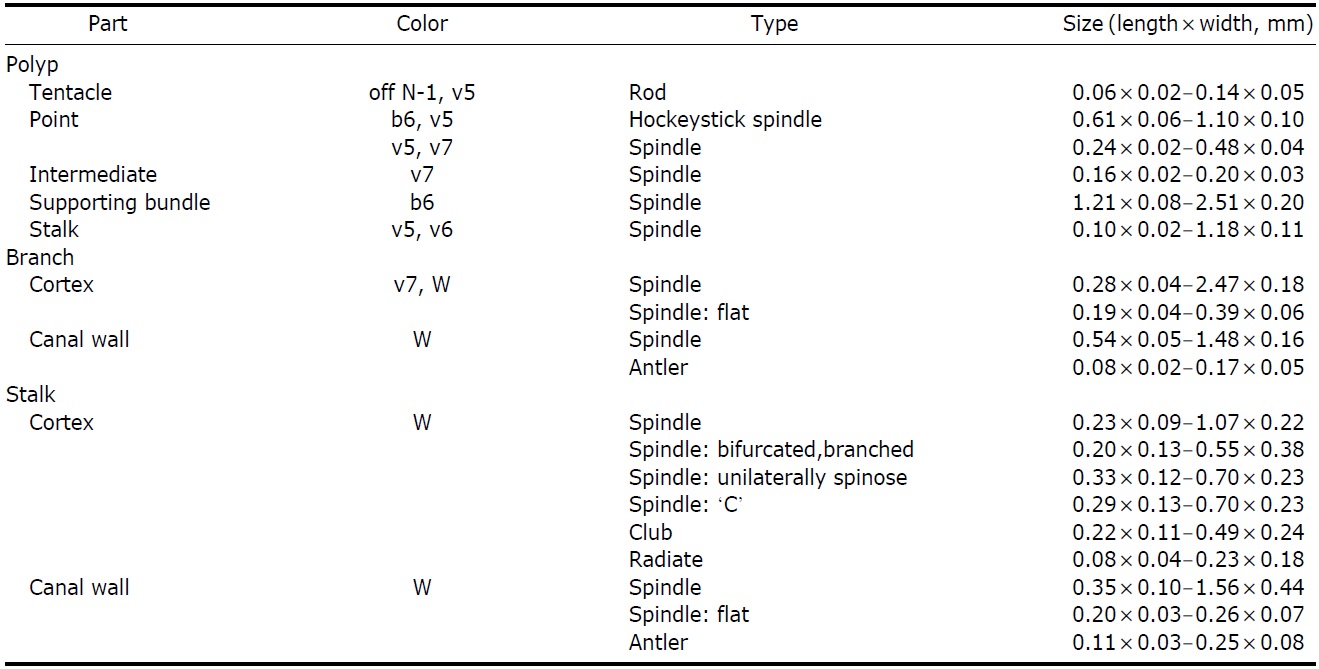
Diagnostic characters on sclerites of Dendronephthya (Dendronephthya) mucronata
white. In alcohol, stalks, main stems, branches wear paler, and especially upward stalk.
Habitat. This species inhabits on the gentle slope of rocks between depth of 10 and 23 m, and colonies showing the color variation with red and yellow live together.
Remarks. This species was characterized by glomerate colonial form and flat polyp head with markedly projected and large points. And also, two color types of red and yellow were described by Kukenthal (1905) from the type locality. Some of these specimens differ from the previous records in having the one or two intermediate slcerites, and little shorter spindle in branch cortex. For the rest, there is a considerable agreement with
Distribution. Pacific Ocean: Korea (Jejudo Island), Japan (Okinawa), Palau, Indonesia (Borneo, Sumatra, Kei Island).
1*Dendronephthya (Dendronephthya) mucronata (Putter, 1900) (Table 3, Figs. 4,7A, B)
1974b: 96; 1977: 174; Imahara, 1991: 78, text-fig. 16, Pl. 2, fig. g.
Material examined. Korea: 1 colony, Jeju-do: Seogwipo-si, Daejeong-eup, Songaksan, 21 Oct 1998, Song JI, Lee YJ (EWZS3958); 1 colony, Seogwipo-si, Daejeong-eup, Gapado, 4 Jan 2006, Choi EJ, Hwang SJ (EWZS1254), 12-20 m deep by SCUBA diving and underwater camera.
Description. Glomerate. Compact, rigid colony with short and wide stalk. Height of colony over 50 cm in alive. But, small specimen of colony 78 mm high, 55 mm wide, of which sterile stalk 30 mm long, 24 mm wide. Main branches four, and short, lobe-like terminal branches grouped on main branches, stem. Foliaceous lower branches short or widen, and covered upper part of stalk or not. Rounded lobes of polyp bundles closely covered main stem and branches. Each bundle composed of 15-25 polyps.
Polyps about 2.7-3.2 mm long with 0.8-1.1 mm of stalk. Flat polyp head stands at obtuse angle with stalk, 0.52-0.74 mm high and 0.77-0.99 mm wide. Anthocodial armature composed eight pairs of points. Usually one of uppermost pair like hockeystick, larger and longer, distinctly projected from polyp head about 0.23-0.46 mm, sometimes up to 0.60 mm with obliquely upwards thorns on free end. Intermediate sclerites between each pair of points absent, sometimes one. Crowns and supplementary sclerites absent. Tentacle sclerites loosely in rows, sometimes unseen. SBs normally composed of three or four spinose spindles and two or three smaller spindles, two or three spindle projected from head over 0.74- 1.22 mm. Long and thick spindles on stalks, sometimes densely.
Anthocodial grade and formula:
IV=1P+(1-3)p+0Cr+very strong SB+ (0 or sometimes 1/2)M
On cortex of branch, spinose or warty spindles densely disposed, mainly straight or slightly curved, varying in size. Larger spindles sometimes yellow. Smaller spindle rather flat. Various types of sclerites on cortex of stalk, warty or spinose spindles majority, straight or bent, sometimes bifurcated or branched. Others unilaterally spinose spindles, unique bow-shaped spindles like ‘C’, club, radiate. On canal wall of branch, straight or curved spindles, antler. On canal wall of stalk, spindles and antler. Spindles sometimes bifurcated or branched, and smaller spindles flat. Detailed color, type, and size of sclerites of each part measured in Table 3.
In living, stalk, main stem, white or light red, and paler upward, while branch light red in larger colony and white in smaller colony. Sclerites of polyp golden yellow, and free tip of SB and uppermost point somewhat white. Sometimes, slcerites of tentacle, points, ventral side of polyp stalk red. In alcohol, stalk, main stem, branch get paler, and especially upward stalk.
Habitat. This species inhabits on the gentle slope of rocks between depth of 12 and 20 m.
Remarks. This species was characterized by glomerate colonial form and lobe-like polyp grouping. This species has also simple anthocodial formula like
Distribution. Pacific Ocean: Korea (Jejudo Island), Japan (Nagasaki, Okinawa), East China Sea, Vietnam, Indonesia (Palu, Mamuju), Fiji, Australia (Bowen, Port Denison).
1*Subgenus Roxasia Utinomi, 1962
Diagnosis. Colonial growth form divaricate by branching abundantly, diverging polyp bundles from one another, scattering polyps on slender twigs, and not forming bunches of polyp bundles or umbels.
2*Dendronephthya (Roxasia) decussatospinosa Utinomi, 1952 (Table 4, Figs. 5,7C, D)
Material examined. Korea: 10 fragments, Jeju-do: Seogwipo- si, Seogwipo Port, 12 Apr 1975, Rho BJ, Song JI (EWZS 3874); 1 frag., Seogwipo-si, Seogwipo Port, 33°13′52.09′′N, 126°33′58.68′′E, 23 Jun 2005, in the Sea Korea (EWZS1233); 1 colony, Seogwipo-si, Munseom, 33°13′32.45′′N, 126°34′ 06.84′′E, 27 Nov 2005, Hwang SJ, Choi EJ (EWZS1232); 1 frag., Seogwipo-si, Seopseom-Jigwido, 33°14′02.68′′N, 126°37′00.85′′E, 15 May 2007, Cho IY (EWZS228); 1 frag., Seogwipo-si, Seopseom, 33°14′23.28′′N, 126°37′50.14′′E, 9 Sep 2007, Hwang SJ, Cho IY (EWZS1433); 1 frag., Seogwipo-si,
[Table 4.] Diagnostic characters on sclerites of Dendronephthya (Roxasia) decussatospinosa
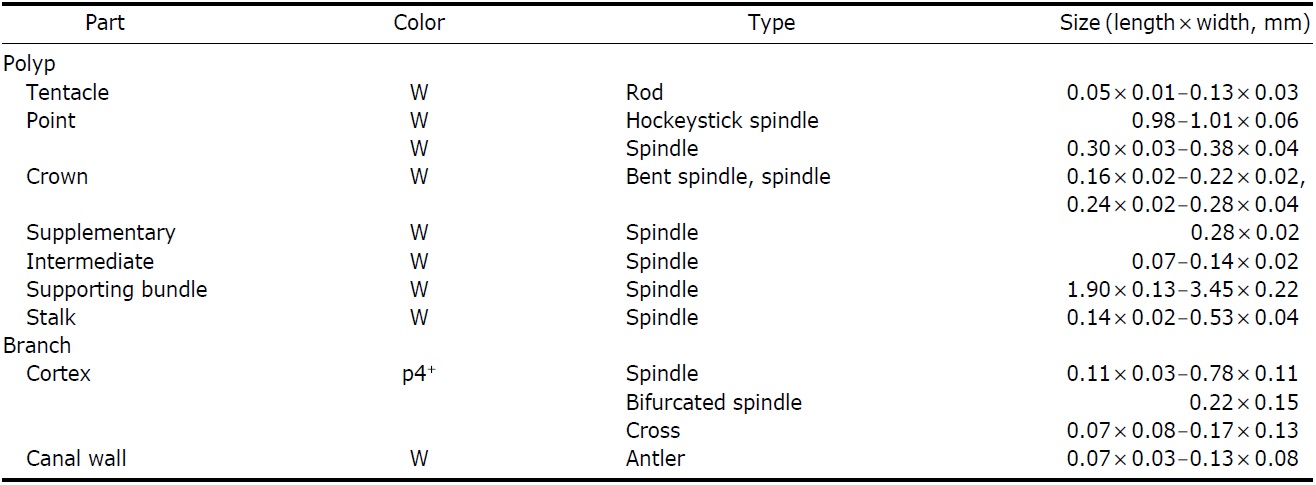
Diagnostic characters on sclerites of Dendronephthya (Roxasia) decussatospinosa
Munseom, 33°13′38.83′′N, 126°33′47.60′′E, 20 Jun 2010, Hwang SJ et al. (EWZS4037), 24-32 m deep by SCUBA diving, fishing nets and underwater camera.
Description. Divaricate. Arborescent colony with long stalk in one plane and flattened. Height of colony up to 100 cm in alive. But, small specimen of colony 145 mm high, 125mm wide, and 47 mm thick, of which the sterile stalk 80 mm long, 26 mm in wide, and 21 mm thick. Stalk occupies over half of whole length of colony in contracted state, and one third of colony in expanded state. Polyparium branched up to 3th ramifications. Primary branches symmetrical from erect main stem, long, and six in number. Branches of middle longer than upper and lower ones, and base of two lowest branched from stalk distinctly foliaceous. Primay branches 40-106° from main stem, with decrease to upward, and secondary ones 80-115°from former ones. Groups of polyp bundles at twig on main stem of polyparium and branches, and umbel shape in large colony. Bundles composed of two groups of 5-10 polyps branched dichotomously.
In expanded state, polyps about 2.5-5.0 mm long with 1.1-2.6 mm of stalk, attaining 2.0-3.3 mm in length except for projecting portion of SB. Polyp head stands at obtuse or right angle with stalk, 0.36-0.67 mm high and 0.50-1.00mm wide. Anthocodial armature composed eight pairs of points. Usually one of pair larger and longer, hockeystick like large uppermost point projected from polyp head about 0.21-0.46 mm. Sometimes, crowns and supplementary sclerites en chevron or horizontal. Tentacle sclerites in two rows rod. SBs normally composed of three sclerites with numerous fine spines, sometimes one. One sclerite with smooth free tip of SB projecting from polyp head about over 0.53 mm, up to 1.94 mm. Ventral side of necks devoid of sclerites, and numerous sclerites on lateral side.
Anthocodial grade and formula:
VI=(1-2)P+(2-3)Cr+(2-4)Sup+very strong SB +(1/2-2)M
Spindle on cortexes of branch densely disposed, and mainly straight or little curved, rarely bifurcated or cross. Canal walls have a few of antler. Color, type, and size of sclerites of each part measured as follow.
In living, main stems, branches, and twig pinkish purple, while polyps and stalk of polyps pale pink. Sterile stalks light pink or purple, and paler upward. And also, color tone more or less variable according to colonial size, showing darker color in small colonies. In alcohol, all colors wear paler, and especially upward stalk, polyps and stalks of polyp somewhat white.
Habitat. This species inhabits on the gentle slope of rocks between depth of 24 and 32 m. This dendronepththyan shows ectosymbiosis with
Remarks. When this species was recorded by Utinomi (1952), he just examined one relatively small colony less than 20 cm in height. Our specimens were differed from the Utinomi’s type specimen by having a few antlers in the canal wall, and showing pink to pinkish purple of stems and branches in color. And also, polyps and sclerites from our specimens were rather larger than those of type specimen.
Distribution. Pacific Ocean: Korea (Jejudo Island), Japan (Seto).
Korean name: 1*??????????? (???), 2*??????????? (???)
Korean name: 1*???Ŀ????????? (???)
Korean name: 1*????????????? (???)
Korean name: 1*???????????? (???), 2*????????????? (???)
